You're not too fat, you're under-muscled (Patreon)
Downloads
Content
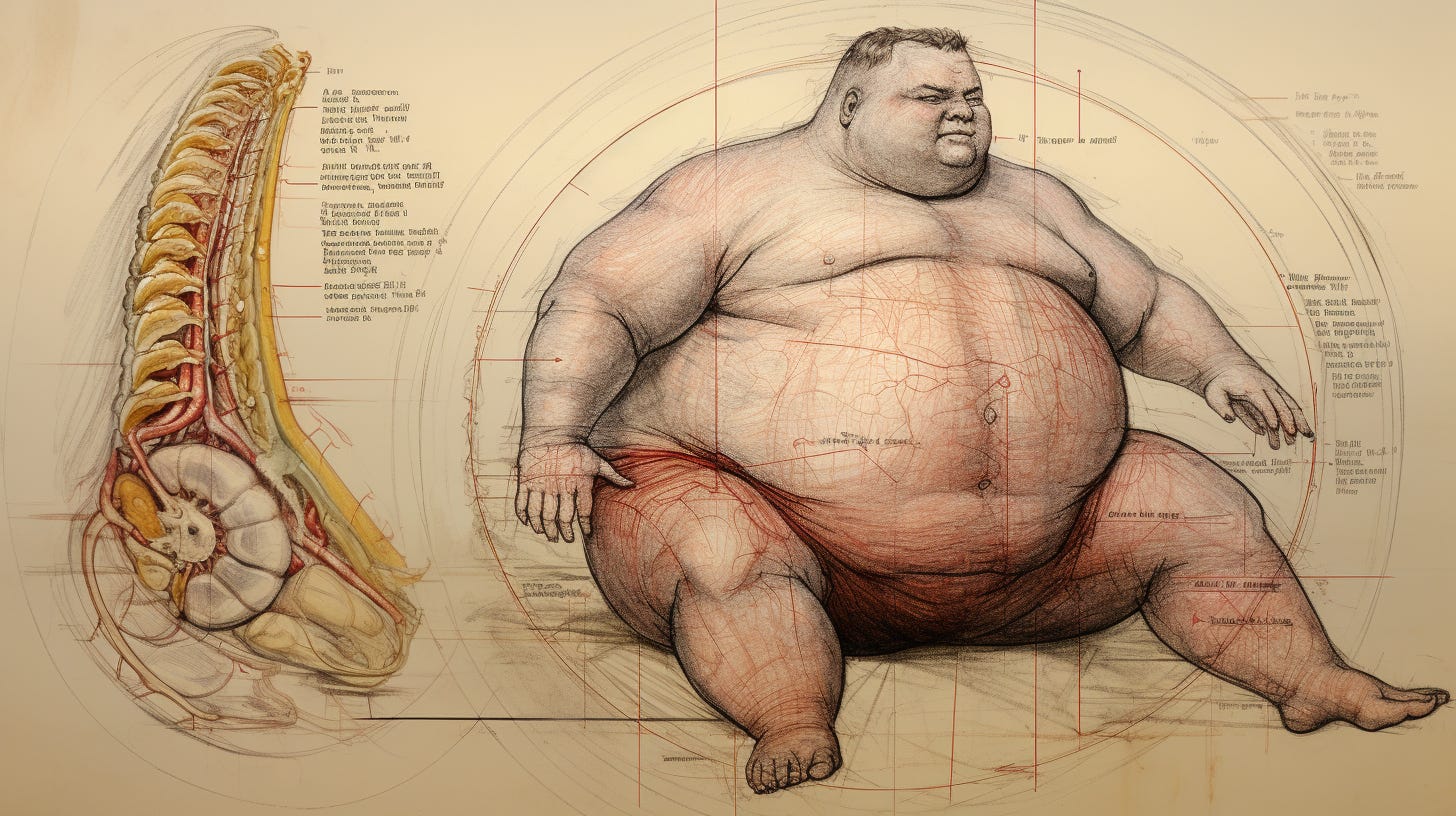 </figure>
</figure>What if people nowadays aren’t suffering from a problem of too much fat but too little muscle?
“All of my sickest patients had one thing in common. They all had unhealthy muscle,” Dr. Gabrielle Lyon told her TEDx audience. “73% of adults are either overweight or obese. Our health is in shambles because of our obsessive focus on body fat.” Dr. Lyon says that the reason so many of us are struggling is because we’re missing that “obesity at its core is a disease of the muscle.”
Last time, we talked about the protein leverage hypothesis which says that because the body is prioritizing protein, you will be hungrier eating a low-protein diet. Eating a high-protein diet will hit your protein needs on less calories. Several studies support this notion.
A study from just this year found that on average, each 1% increase in protein lowers total calorie intake by about 1%. A 2011 study found that people ate more calories if they ate a 10% protein diet instead of a 15% protein diet. Another study found people with pre-diabetes lost more weight on a 30% protein diet than a 15% protein diet.
<figure> </figure>
</figure>This time around we’re going to answer two questions:
(1) Why is muscle important to health and obesity?
(2) What is the benefit of eating more protein?
You need protein for a countless number of things: to keep your skin, bones and muscles healthy; protein is used to make neurotransmitters and hormones. Things like dopamine, serotonin, epinephrine, norepinephrine, and thyroid hormones all require protein. Before we get ahead of ourselves, let’s look at how muscle (which is built up by protein) helps you make sure you’re achieving baseline health.
As we go through the next sections, keep this in mind:
reduced muscle mass and strength is commonly associated with many chronic diseases, including obesity and insulin resistance.(S)
Also, I think muscle explains why bodybuilders make fun of low-carb dieters so often.
The lowest bar for being healthy
The most important thing about healthy muscle is that it shields you from developing metabolic syndrome also “insulin resistance syndrome.”
Insulin is what allows you to take sugar out of the blood and put it in the cells so it can be used. If your tissues are insulin resistant it means your insulin doesn’t ‘work’ as well, so you need more insulin to properly manage incoming sugar. (Note: I’m using “sugar” interchangeably with “glucose.”) If you’re insulin resistant, you’re on a very unhealthy path to diabetes. Diabetes is kind of an epicenter for all kinds of health issues. It is a well known risk factor for cancer and you’re twice as likely to have a heart attack or stroke if you have diabetes. Even though it’s several steps before actual diabetes, we really don’t want to be insulin resistant. Dr. Peter Attia says:
“If you have even the mildest interest in being healthy, you can’t be insulin resistant. …If you are insulin resistant, you are not going to be healthy.”
<figure>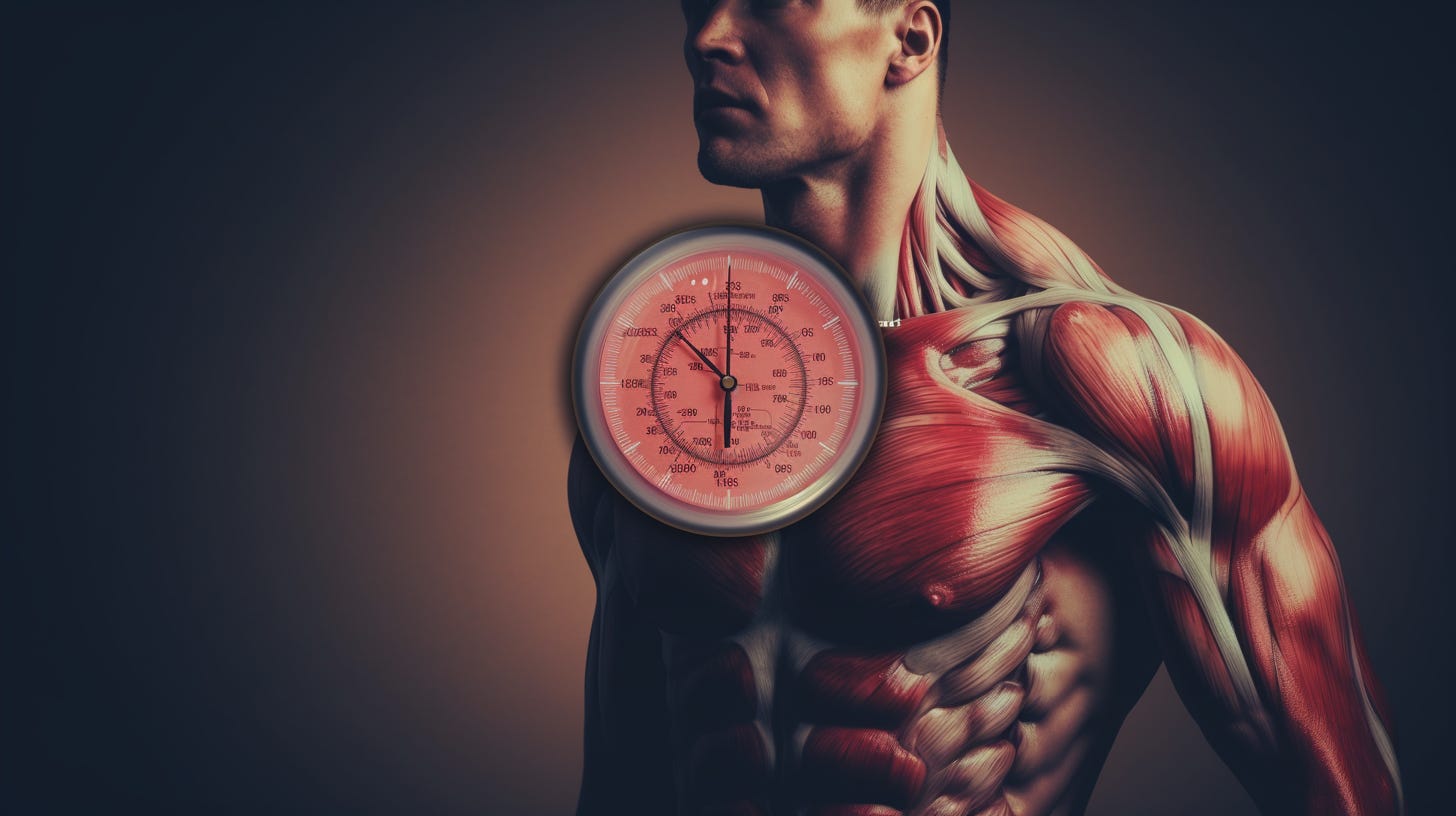 </figure>
</figure>So what does muscle have to do with all this?
To make this really simple:
・When you eat carbohydrate, it is broken down into glucose.
・Insulin takes the glucose out of the blood stream and puts it into various cells so you don’t have super high blood sugar just from eating a croissant. (Note: Blood Sugar is also referred to as Blood Glucose)
・However, Muscle is the key glucose sink that absorbs most of the glucose.
・The muscle can either ‘burn’ the glucose for energy or store it. The muscle can store a lot of glucose, and the liver can store a little bit.
・When the liver is full of stored glucose and there’s more glucose than the muscle can handle, the glucose gets turned into fat in the liver. (Note: This process is called De Novo Lipogenesis i.e. ‘New Fat Making’)
・This fat made in the liver gets stored in your fat tissue.
・If this process happens excessively, that fat made in the liver eventually gets stuck in the liver and lodged muscle. This indicates that you’re becoming insulin resistant. A key feature of insulin resistance is that you become worse at processing glucose.
・Muscle mass decline worsens insulin resistance because there’s less muscle to get rid of the excess glucose.(S)
・On the other hand, more muscle mass means less insulin resistance and more muscle to clear glucose from the blood (also called “glucose disposal”).(S)
“Deficient glucose transport and glucose disposal are key pathologies leading to impaired glucose tolerance and risk of type 2 diabetes. …One of the central metabolic features of type 2 diabetes in humans is decreased glucose disposal.”(S)
So in essence, muscle is shielding you from the issues of excess glucose.
<figure> </figure>
</figure>Why Bodybuilders fight with Ketogenic dieters
This is really interesting because I think it explains why bodybuilders and low-carb dieters are somewhat at odds with each other.
<figure>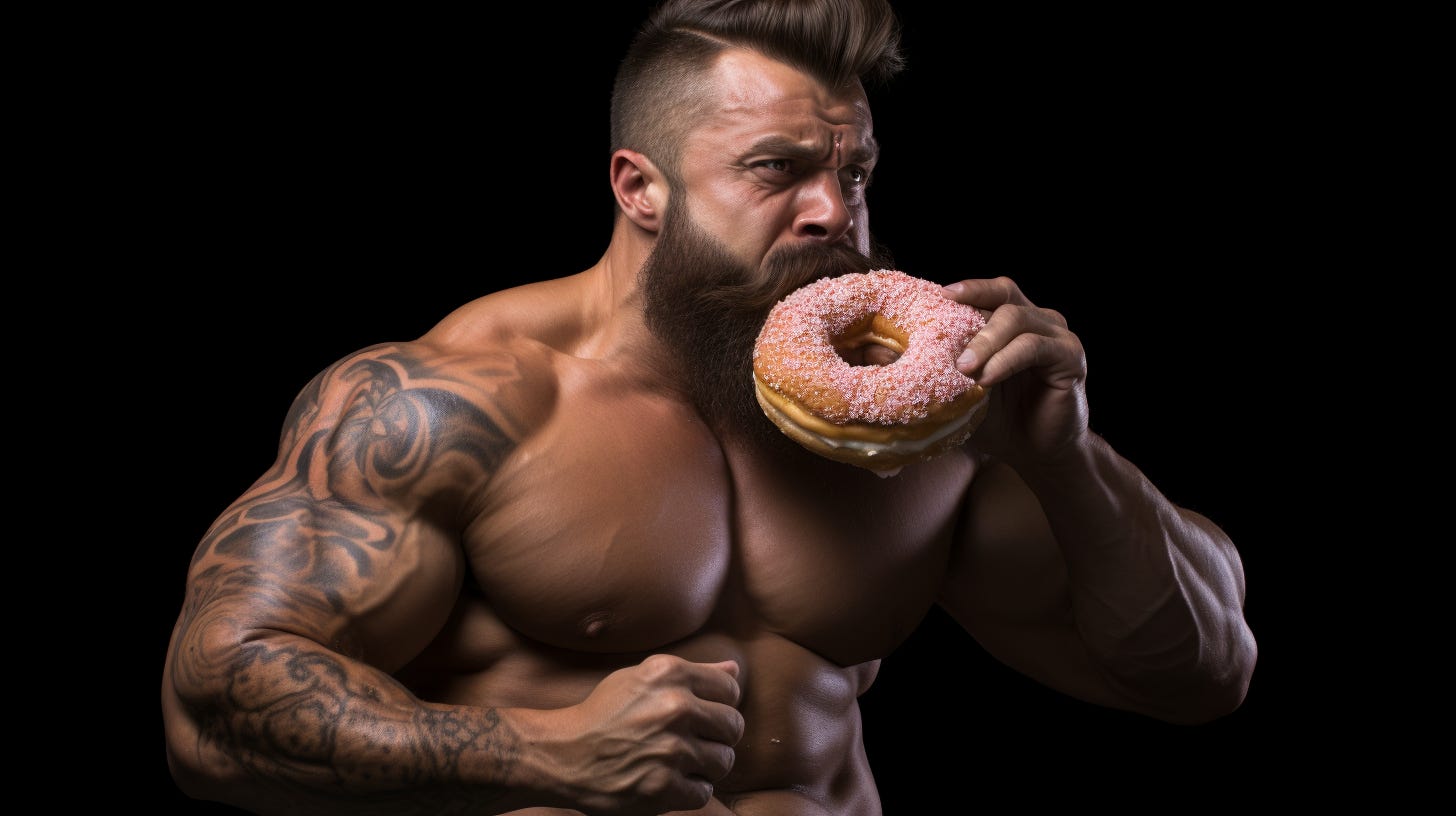 </figure>
</figure>How could carbs ‘make you fat?’ Bodybuilders, athletes and fitness enthusiasts eat plenty of carbs and have a great body composition.
<figure>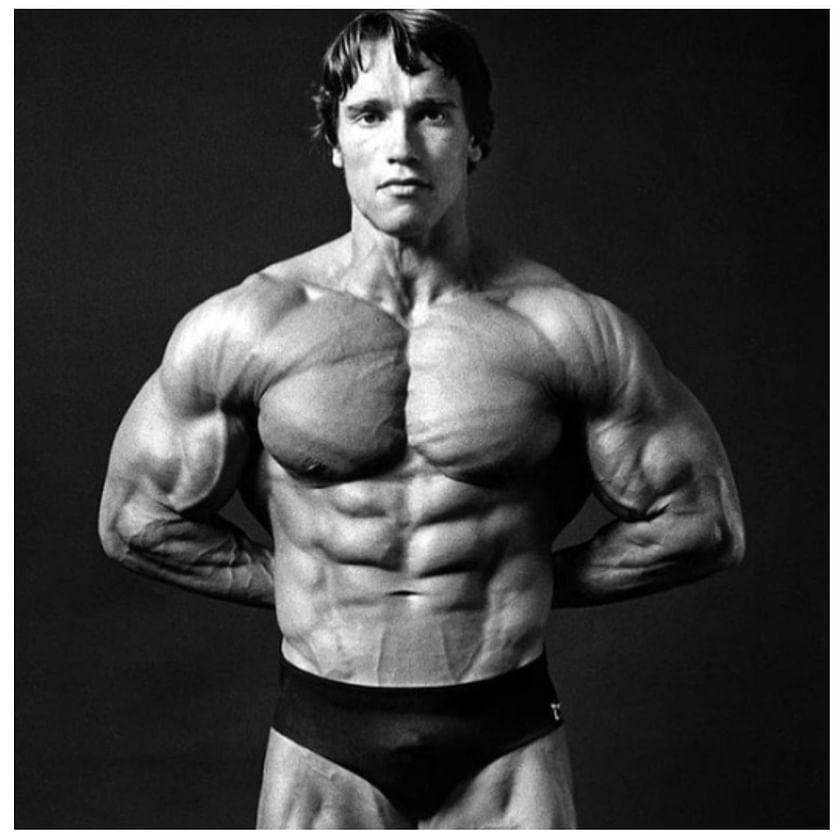 </figure>
</figure>As Dr. Peter Attia said, if you want to be even mildly healthy, you at least need to not be insulin resistant. A key feature of insulin resistance is that you can’t process carbohydrate properly and insulin resistance is the linchpin for developing many health ailments. Building muscle is important because:
・Insulin resistance starts in the muscle. (S)
・Exercising makes your muscles more insulin sensitive - the insulin works better.(S)
・Having more muscle means you can dispose of glucose more effectively.(S)
So exercising and building muscle are great for handling glucose. Low-carb dieters take a different strategy: They just don’t eat glucose so they don’t have to worry about handling it.
When a type-2 diabetic eats a typical carb-rich diet, they have to inject extra insulin because their own body’s insulin doesn’t work properly. They have trouble handling glucose.
A bodybuilder might say: Hit the gym so you can process that carbohydrate better.
A low-carb/keto enthusiast might say: If you can’t process carbohydrate properly, just don’t eat it.
 </figure>
</figure>So where does protein come in all this?
Consider that a 2022 study found more total protein eaten was associated with less incidence of insulin resistance syndrome. Another 2019 study found that higher total protein intake was associated with a reduced risk for diabetes and pre-diabetes. Another study comparing a 30% protein diet to a 15% protein diet in people with pre-diabetes found all people people on the high protein diet reversed their prediabetes.
We discussed last time how protein increases satiety and makes you eat less. Losing weight is great for fixing insulin resistance.
Now, let’s talk about protein’s effect on muscle. As we all know, protein is a nutrient that builds muscle.
This study did an analysis of 105 different studies to understand the effect of a wide range of dietary protein intakes’ effect on muscle mass. They were looking at doses anywhere from 0.5g to 3.5g of protein per kilogram per day. (Keep in mind that as we discussed last time, the RDA is set at a very low 0.8g/kg per day). The study found that the more protein people ate, the more muscle mass they had and even as little as an extra 0.1g/kg helped people preserve muscle mass and potentially increase it. They also noted that the people eating under 1.3g/kg of protein a day stood to benefit greatly by increasing their protein intake. As you increase past 1.3g/kg you’re still getting benefits but they’re not as pronounced. However, if you add resistance training along with protein in excess of 1.3g/kg you can derive a lot more benefit to the muscle.
Put simply, what the study suggests is: The more protein you eat, the better for muscle. If you combine increased protein intake with resistance training, the muscle benefits much more.
Now, I’m not saying you can just sit on the couch all day long, eat steaks and expect to wake up looking like a Belgian Blue Bull.
<figure>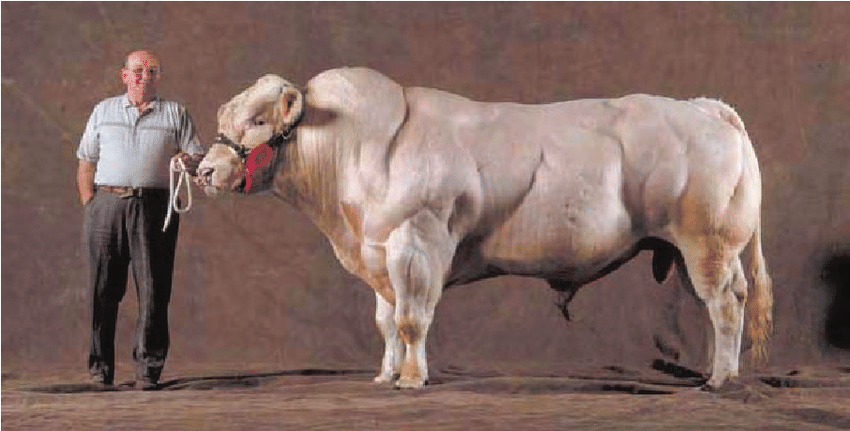 </figure>
</figure>As Dr. Stuart Phillips explained in a presentation of his, your muscles are always cycling between an anabolic (building up) and catabolic (breaking down) state. To build up muscle, you want to increase muscle protein synthesis (yellow line in picture below) and you want to suppress muscle protein breakdown (red line below). The green area in the picture below represents muscle accumulation, the white represents muscle breakdown.
<figure>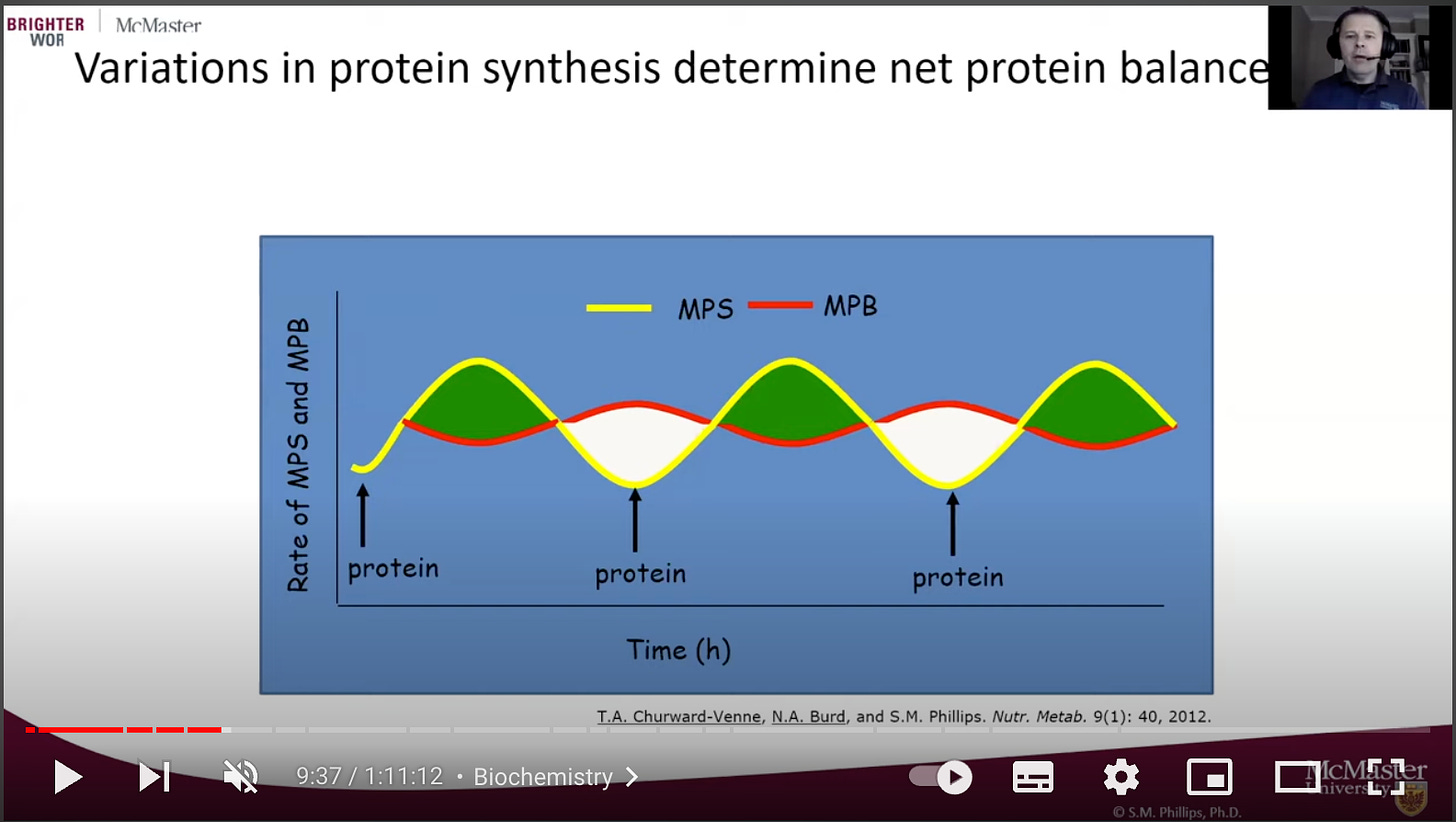 </figure>
</figure>Eating protein is what triggers this muscle accumulation state where muscle protein synthesis is greater than muscle protein breakdown. So one thing to consider about the study presented earlier is that one aspect of the high-protein intake leading to higher muscle mass is from having less muscle breakdown. What I mean to highlight is that protein is great because it helps you have more muscle mass, but it’s also great because it prevents muscle breakdown.
<figure>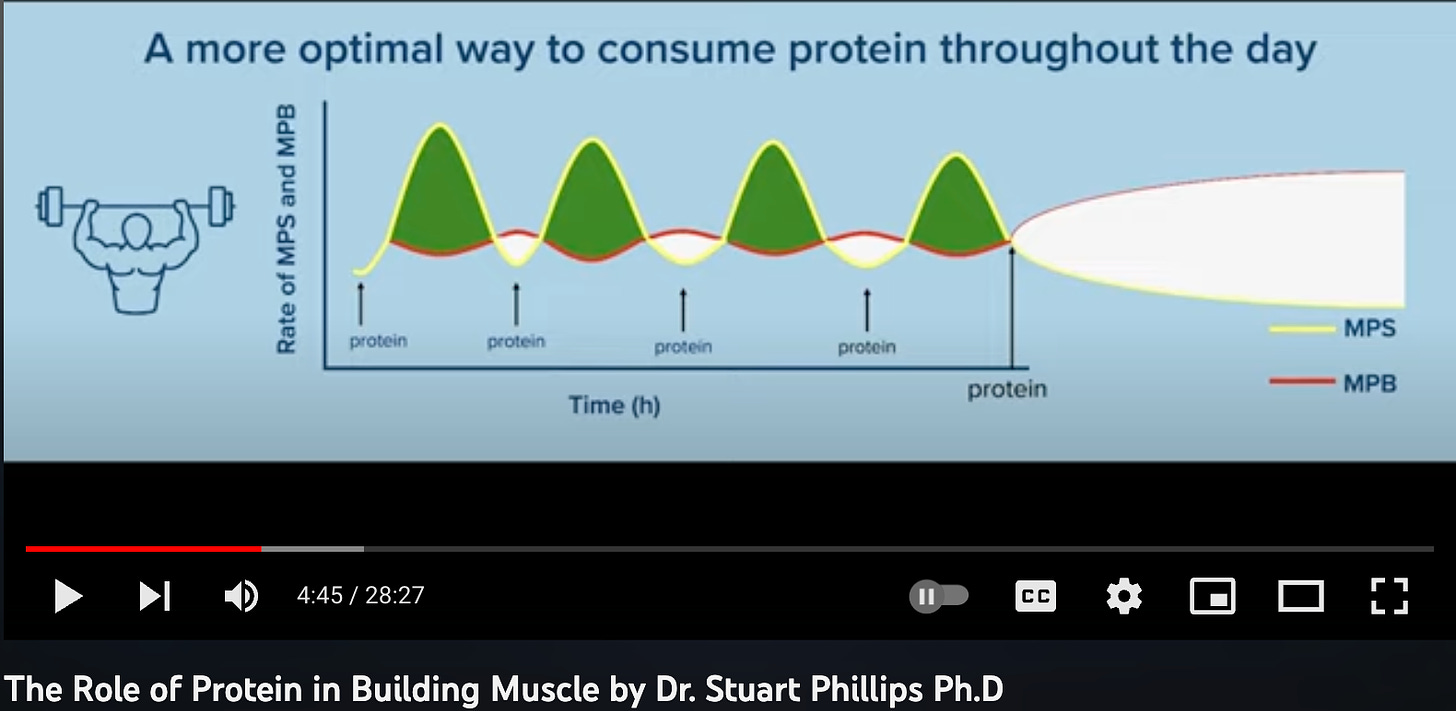 </figure>
</figure>Wrapping up what Dr. Stuart Phillips was saying, as you’d expect, you have much greater muscle accumulation when you add resistance exercise to your protein filled routine.
According to the 2019 paper Dietary Protein and Muscle Mass: Translating Science to Application and Health Benefit,
Increased protein intake contributes to greater strength and muscle mass gains when coupled with resistance exercise, allows for greater muscle mass preservation when consumed during periods of negative energy balance, limits age-related muscle loss, and, to a lesser extent, provides a greater muscle protein synthetic response when evenly distributed across meals.
A couple years ago, I had a girlfriend who watched her calories closely and was pretty thin. I asked her why she ate so little and she said she’s just always eaten like that since she got into modeling. She also often had quite rough upper back pain. I was giving her a massage one day and noticed her upper back muscles were very thin, it felt like a big flat rubber band. I asked her what she usually ate and her diet had barely any protein in it. It sounded like her protein intake wouldn’t even hit the minimum daily requirement for protein of 0.8g per kg bodyweight.
Consuming higher amounts of protein during typical moderate energy-deficient weight loss diets (i.e., 500–750 kcal/d deficit) preserves muscle mass in an otherwise catabolic physiological environment.
It’s a shame that the conventional stress on calories in calories out didn’t come with a warning to make sure to increase your protein to avoid muscle breakdown when you’re cutting your calories.
With moderate energy deficit, however, protein intakes on the order of double the current RDA (i.e., 1.6 g/kg/d) have proved efficacious in preserving muscle mass during weight loss.
…In the absence of sufficient dietary protein intake, muscle is catabolized to provide amino acids to allow for continued endogenous protein synthesis in critical physiological tissues and organs.
…Improper application of the protein RDA in federal policy, which informs institutional feeding practices, can result in dietary protein intakes that may be sub-optimal for muscle growth and preservation and overall health.
(From Dietary Protein and Muscle Mass: Translating Science to Application and Health Benefit)
One thing I’ll mention here is that you want to focus on getting high quality protein. I talk all about protein quality in a video of mine titled Protein is not protein. Here’s why. Make sure to check it out if you’re not familiar with the concept of high quality and low quality proteins.
Finally, on a practical note, Dr. Gabrielle Lyon says that to stimulate protein synthesis you either need to eat 3 meals with at least 30 grams of high quality protein or 2 meals with at least 50 grams of high quality protein. And don’t slowly snack on protein. You want to eat each of those 30 grams or 50 gram servings of protein in time frames of about 30 minutes.
